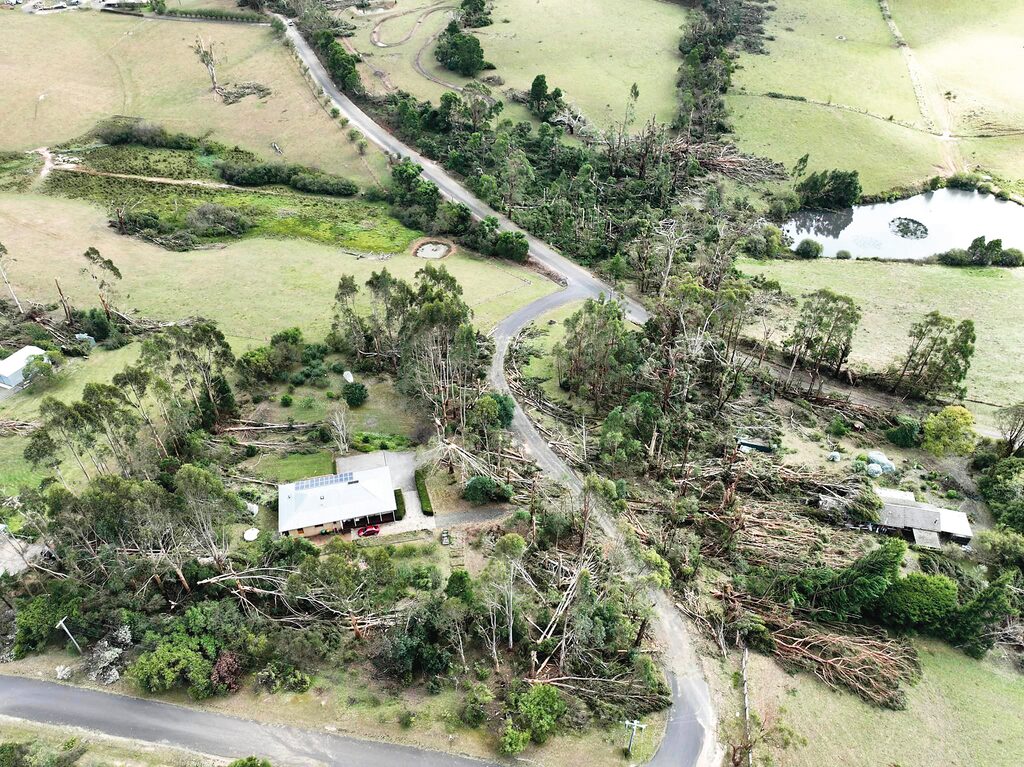By ZAIDA GLIBANOVIC
RECORD winds were recorded from the storm that struck Mirboo North on Tuesday, February 13.
A Bureau of Meteorology (BoM) spokesperson said Yarram Airport recorded a wind gust of 126 kilometres per hour as thunderstorms went through the area.
“(It was) a record wind gust strength at the weather station,” the BoM’s spokesperson said.
So, how did this severe thunderstorm occur, and are we in danger of it happening again?
The BoM issued a severe thunderstorm warning with damaging winds for the afternoon of Tuesday, February 13.
But even the BoM couldn’t predict just how damaging those winds would be, ripping through power infrastructure and leaving half a million customers without power across the state.
Though the storm was felt in other parts of Victoria, it seemed to have fallen directly on top of Mirboo North and surrounding towns.

“Thunderstorms over west, south and east Gippsland developed in an atmospheric environment that was conducive to producing severe thunderstorms,” the BoM spokesperson said.
“This included warm conditions, ample amounts of atmospheric moisture and enough wind shear to allow thunderstorms to become organised.”
Severe thunderstorms can happen at any time of the year. Thunderstorms need three main ingredients to form: moisture, atmospheric instability, and a lifting mechanism.
So when the air is humid, there’s a rapid decrease in temperature with height and with an approaching front or low-pressure trough, a thunderstorm will most likely occur.
Federation University’s Dr Savin Chand, who focuses his research on severe weather events and climate extremes, said though severe thunderstorms have occurred in the past, extreme weather events are becoming more frequent and damaging.
“Severe storms have been happening in the past. It wasn’t all of a sudden that we’re seeing extreme thunderstorms happen,” he said.
“What we generally see over at least the past three-four decades, the number of these events, the frequency of some of these events have increased.
“One of the reasons we see now is because of climate change, anthropogenically induced global warming – the atmosphere now is warmer than it used to be – it’s not just warm as in the context of Australia, it can hold more moisture.”
Dr Chand said conditions are more conducive for extreme weather events, which is why we see events more frequently, with more rainfall and stronger winds.
“As a result, we tend to see more rainfall with these events and more winds associated with these events – in other words, things get a bit more disastrous,” he said.
Dr Chand said it’s very hard to predict which specific areas will cop the worst of the thunderstorms, but extreme conditions are easy to predict.
In regard to Mirboo North’s extreme case of storm damage, Dr Chand said a reason for the storms selective strike path was because the thunderstorm was so severe and strong on a small scale with a front of only 500 metres wide.
Dr Chand said more research into severe thunderstorms is needed.
“I think there needs to be more research into how those sorts of events happen, it was so severe, moved across very epically, left several regions but affected the others … that’s the huge questions that we’re asking,” he said.
“The whole dynamics about the predictions and preparations should change … things are a bit different these days.”
The Federation University researcher says community participation is important for the future. He says the community can assist with assessing how predictions can be interpreted and contextualised locally.
Independent probe into Victoria’s biggest blackout
CALLS have been answered: the state government will review Victoria’s biggest blackout.
The state government will commission a supplementary independent review into the electricity distribution system’s response to the devastating February 13 storms that left half a million Victorians without power due to significant damage to power infrastructure.
The review will be led by a panel of independent experts, not politicians, the state government stated.
The independent review will aim to focus on the operational arrangements and preparedness of energy distribution companies to respond to these extreme weather events.
The push to weather-proof Australia’s electricity grid has grown stronger after the storms, with the Minister for Energy, Lily D’Ambrosio, stressing the need to make the grid more resilient in the face of climate change challenges.
The state government review into the blackout will include research into the distribution businesses management of the incident as well as the timely and effective restoration of supply. The report will also compare the operating models of energy network companies.
It will also investigate if there were any opportunities that could have reconnected customers more quickly, such as the availability of field crews and technical expertise through the use of mutual aid agreements and resource sharing within Victoria, or from interstate resources.
Also probed will be communications with customers, the effectiveness of information platforms and services, such as outage trackers, and preparedness to administer relief to impacted communities.
The Australian Energy Regulator’s will advise on the energy resilience requirements of energy infrastructure companies.
The state government says that the final scope of the independent review will be given detailed consideration, and will build on the work of the Electricity Distribution Network Resilience Review that followed two storm events in 2021 and focused on the resilience of physical grid infrastructure.
The recent catastrophic storm event that damaged 12,000km of powerlines and poles across the state’s electricity distribution businesses caused widespread power outages.
The state government says that as the climate changes, catastrophic events and destructive weather patterns will become more frequent and more extreme. It is critical that electricity distribution networks are able to mitigate, manage and recover quickly from these events.
This review will be undertaken in addition to investigations from Energy Safe Victoria into the tower collapse and the Australia Energy Market Operator into system response and security.
Ms D’Ambrosio said the state government was looking for answers regarding the state’s blackout.
“For many Victorians this emergency situation is still live, we are working closely with distribution companies to connect the remaining Victorians to power as our first priority, after reconnecting 90 per cent of customers in the first 48 hours,” she said.
“We want to get to the bottom of exactly what has occurred, and an independent review will ensure that private distribution companies learn valuable lessons from what happened.”
However, the state Opposition criticised the announcement, saying the review came after the Opposition first demanded a Parliamentary Inquiry into the state’s energy transmission network.
The Leader of the Opposition, John Pesutto, said the announcement was a “sham” with “no details about who will conduct it”.
The Shadow Minister for Energy, Affordability and Security, David Davis, said Labor wanted to have a secret review.
“Victorians deserve a public inquiry where experts can be called to give evidence and shed light on what went wrong,” he said.
“Labor has received a number of warnings in multiple reports about the problems with our electricity infrastructure yet has chosen to ignore them all.”
A recent news article in The Age reported that an assessment done by AusNet Services found almost one in every seven of the state’s 13,000 transmission towers is damaged and has extensive rust.
Recent reports state much of Victoria’s transmission network consists of structures originally designed between the 1960s and 1980s, with the average transmission tower age assumed to be more than 50-years-old in 2024.
AusNet, the private company that control those transmission lines, said their historical infrastructure could not withstand the extreme weather events of the day,
Recent reports published in November, 2023 by the sector’s watchdog, Energy Safe, uncovered issues with maintenance on Victoria’s transmission network.
The storm event of February 2024 has many discussing the possibility of underground power lines to avoid the same power outage disaster. But placing the network underground is more expensive, given the extreme costs associated with digging trenches for tens of thousands of kilometres worth of transmission lines in the state.











